Food Safety
Getting Pressure to Remove the Heat?
High-pressure processing—or cold pasteurization—can be a significant investment, but if your product is perceived as organic, high-end, minimally processed and nutritional, it may well be worth the investment.

If you get a fresh guacamole, you know it doesn’t keep for very long at home in the fridge once you’ve pealed it and used it by itself or in a salad. Good Foods has solved that problem and used HPP to give its product a long shelf life. Applegate’s oven roasted turkey with a resealable container was run through the HPP step in its packaging, designed to work with HPP systems. Images courtesy of Good Foods and Applegate
High pressure processing—or high-pressure pasteurization (HPP)— as we know it got its start back in the 1940s when ASEA (which later become ABB) hired Baltzar von Platen to head a secret project, code-named “Quintus,” to produce synthetic diamonds using a process he invented, which combines heat and extremely high pressure. Quintus Technologies started making industrial equipment for the aerospace and medical industries, and began to research potential applications in the food and beverage industry.
According to Ed Williams of Quintus Technologies, early Quintus HPP research equipment included the QFP 6 to small commercial/pilot plant systems with the 35-L. In the late 1990s, Quintus offered under the Avure name the first true commercial food system with its vertical 215-L system, which is still in operation at several companies such as Hormel Foods, Wholly Guacamole, Perdue Farms and others. Currently, Quintus Technologies offers 150-L and 400-L machines.
“In May 1999, Flow International Corporation purchased the high-pressure division of ABB in Sweden, which manufactured HPP vertical systems (35-L and 215-L) for batch processing of packaged products,” says Dr. Errol Raghubeer, JBTAvure senior VP of HPP science & technology. Since then, most of the current JBTAvure HPP equipment used in the food and beverage industry are horizontal systems with capacities of 100, 350 and 525 liters. The original vertical system, modified to 350 liters, is still being produced and used in the seafood industry for the shucking of shellfish and crustaceans.
Hiperbaric of Spain, which has its roots in high-pressure equipment, has since 1999 installed more than 400 HPP units in food and beverage companies on five continents. “The concept of using high pressure for food preservation has been around since the 19th century, but the technology did not advance significantly until the 1990s,” says Anthony Zapata, Hiperbaric business development manager. “Hiperbaric was founded in 1999 and developed some of the first commercially viable HPP machines.”
“In 2002, Hiperbaric was the pioneer in bringing to market the horizontal high-pressure processing equipment Hiperbaric 300 (300 l – 5000 bar/500 MPa/72500 psi) in the Campofrío meat products plant in Burgos, Spain,” adds Zapata.
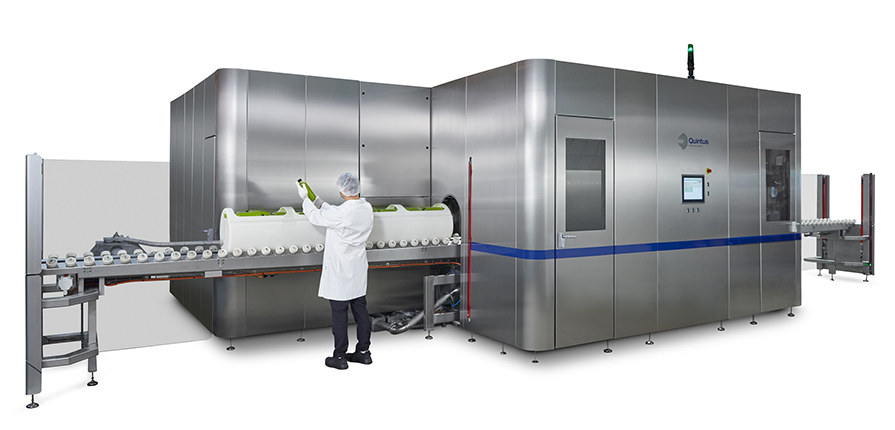
HPP Preferred Applications
“HPP is a non-thermal sterilization technique,” says Tony Moses, director of product innovation at CRB, a CSIA Member. “It works best in applications where high temperatures either negatively impact the quality of the product, such as avocado dips and raw pet food, or the functional properties of the product, such as probiotic drinks and juices. HPP alone is typically not sufficient to create a shelf-stable product, so it needs to be combined with either keeping the product chilled, which is done for avocado dip or juices, or drying the product, which is done for raw pet food.”
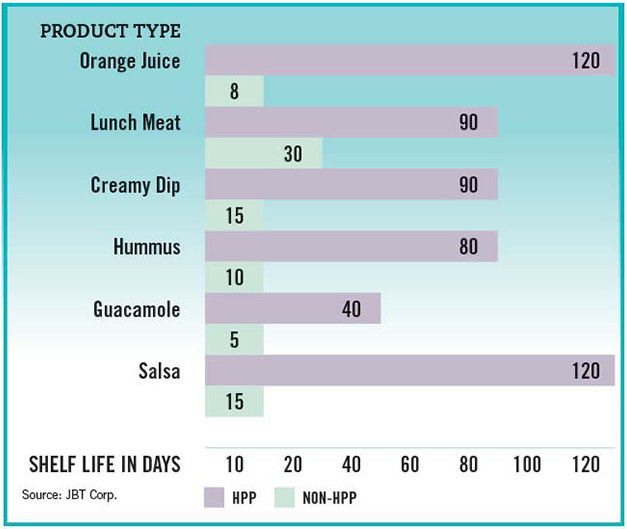
HPP is a non-thermal food processing method that inactivates spoilage microorganisms and foodborne pathogens by using cold water and extremely high pressure, says Qunitus’s Williams. HPP allows food producers to promote food safety while increasing shelf life and maintaining the original, desirable food qualities. HPP is currently applied to several food categories including juice-based beverages, RTE meats, ready meals, baby food, pet foods, seafood and other products where food safety goals are met without the use of chemical preservatives and destruction of natural nutrients. This not only offers food producers a technology to ensure food safety and extension of quality and shelf-life, but also satisfies consumers’ demand for healthier, fresher-tasting foods that are clean label, minimally processed, without chemical preservatives and with reduced sodium content.
“The limiting factor for foods and beverages for HPP application is water activity,” says JBTAvure’s Raghubeer. “Free water is important in the disruption of microbial biochemical reactions and for conformational changes [in] cell membranes. In addition to intrinsic factors such as pH and water activity levels, extrinsic parameters such as temperature of storage and presence of oxygen are limiting factors for certain foods. Current HPP food and beverage application is a pasteurization process requiring refrigeration of most, if not all, HPP treated products. The exclusion of oxygen is of importance for both microbial shelf-life stability and control of oxidative degradation of HPP products.”
Hiperbaric’s Zapata lists some key applications for HPP:
- Cold-pressed juices and beverages—HPP maintains freshness and inactivates pathogens without using traditional thermal pasteurization.
- Guacamole and avocado products—HPP prevents browning and loss of quality.
- Dressings, sauces and wet salads—HPP maintains flavor, texture and color better than heat.
- Compared to other non-thermal technologies, HPP provides higher microbial inactivation levels while maintaining freshness and sensory quality. It also allows processing pre-packaged foods, preventing recontamination.
Recent HPP applications include:
- Raw pet food and nutraceuticals—HPP enhances food safety by achieving a 5-log reduction of vegetative bacteria, yeasts, molds and virus, while preserving the raw and natural profile of raw pet food and nutraceuticals
- Ready-to-eat foods—HPP offers food safety and maintains freshness by extending shelf-life without adding preservatives
- Baby food—HPP reduces microbial risks while preserving nutrients
The use of HPP technology can lead to substantial water and energy savings, when compared to other food processing technologies, having a lesser impact on the environment, adds Zapata. It has been shown that HPP requires less energy per kilogram of food than conventional thermal processes.
“In fact, a study from 2020 compared the impact of processing orange juice with HPP and thermal pasteurization,” says Zapata. “The authors concluded that HPP is on average less environmentally impactful than thermal pasteurization, resulting in fewer carbon emissions. Furthermore, since the water used in HPP does not come in direct contact with the food products, around 85% of the water is reused. It is noteworthy that the remaining 15% of water is not necessarily wasted, as it may be collected for other uses, such as cleaning purposes.”
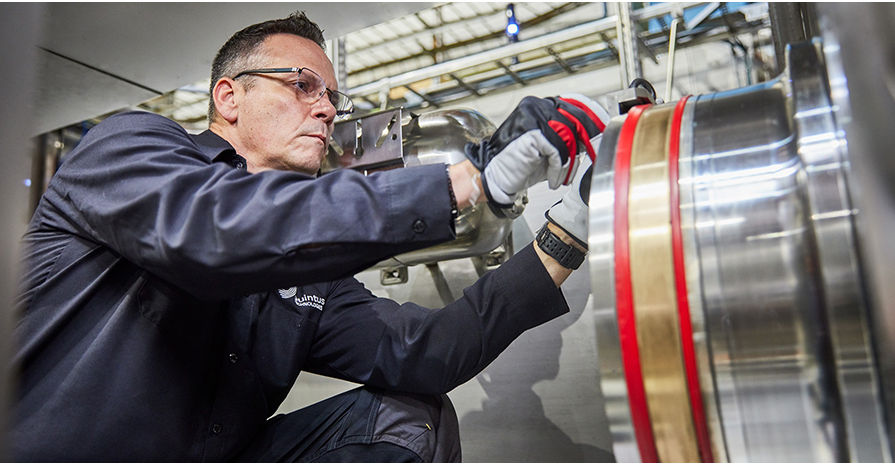
Building Requirements
Like retorts, an HPP installation will make some demands on facility infrastructure. One thing to keep in the back of your mind—should your facility not be able to accommodate an HPP system—there may be a nearby third-party toller that can process your products. Pricing is typically based on a per-cycle or per-pound of product.
Zapata points out some basic facility needs that you should consider before installing in an existing or a new facility:
- HPP systems are large and very heavy (up to 235,000 pounds), so a proper foundation is needed. Adequate space is required for loading/unloading of product around the HPP machine.
- A chiller is required for cooling hydraulic oil and processing water.
- Compressed air is required to manipulate certain components.
- Each model requires electrical infrastructure.
- Internet is needed to enable Hiperbaric’s 24/7 complimentary remote assistant support, which features real-time monitoring and reporting of HPP cycles.
“Although HPP has a higher capital cost than thermal pasteurization, it uses less energy than thermal processes,” says Zapata. “Overall, the benefits of quality, safety and shelf life make HPP a strategic investment for many food/beverage companies despite the higher upfront costs. Thorough cost-benefit analysis is recommended.”
Packaging Requirements for HPP
Materials commonly used for HPP packaging are flexible films, pouches, skin pack, trays, bottles and cups with at least 15% compressibility as products will compress at least 15% of their volume at 6,000 bars, says Quintus’s Williams. Packages need to be hermetically sealed to prevent leakage. Sealing surfaces for top films on trays and cups need to be relatively wide, uniform and preferably flat.
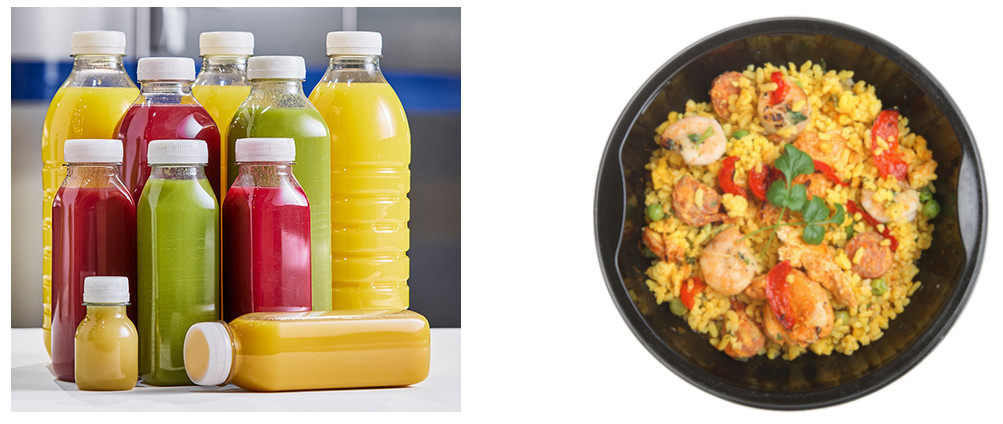
For plastic bottles without an induction safety seal on the lips, specially designed caps/closures are needed to prevent leakage, adds JBTAvure’s Raghubeer. PET and materials with high oxygen (low OTR) and good moisture vapor barrier (MVTR) properties are commonly used for HPP applications to optimize microbial shelf life and reduce oxidative reactions. Care should be taken when thermoforming materials with oxygen barrier (EVOH) layers as overstretching of the material can compromise the EVOH layer, particularly in corners.
Packages must be able to withstand pressure transmitted during HPP. Most plastics and laminated films have enough elasticity, but packages should always be tested, says Zapata.
Hiperbaric has an HPP USA packaging supplier list, which outlines compatible HPP packaging options. Complimentary packaging testing is also offered at its HPP pilot plant facility.
Bulk Liquid Processing
HPP is a batch process. There are costs associated with the startup and shutdown of any batch process, so running fewer, larger batches reduces those costs, says CRB’s Moses. It can also improve throughput time.
Hiperbaric attacked this issue a few years ago (see FE’s Engineering R&D, FEB 2020) with the introduction of a bulk liquid processing machine that could handle up to 10,000 liters/hour when processing liquid in bulk and equipped with two processing chambers of 525-liter volume. Two machines are available—the Model 525 Bulk that handles 525 liters in a single batch or the Model 1050, which handles 1050 liters in a single batch. “The process begins by liquids filling the inlet tank,” says Zapata. “After pressurization, the HPP beverage fills the outlet tank through sterilized tubes and is ready to be bottled in an ultra-clean filling line.”
“Bulk processing of pumpable product will increase product throughput with better usage of the space in an HPP carrier,” says Raghubeer. “This post-HPP fill system, such as JBTAvure’s FlexiBulk system, will give more options in the final packages used, particularly with the environmental constraints of plastic materials. However, these benefits do come with some added cost and restrictions as ultra-clean filling or aseptic filling systems are required.”
“We are looking into more environmentally friendly consumer bulk packages; compressible materials such as plant-based ‘plastic’ materials do not provide the necessary oxygen barrier properties to get the benefits of shelf-life extension afforded by HPP technology,” says Quintus’s Williams. “Bulk systems increase product throughput, which reduces energy cost since a larger volume of products are processed per cycle. This allows for more environmentally friendly packaging options such as glass and paper.”
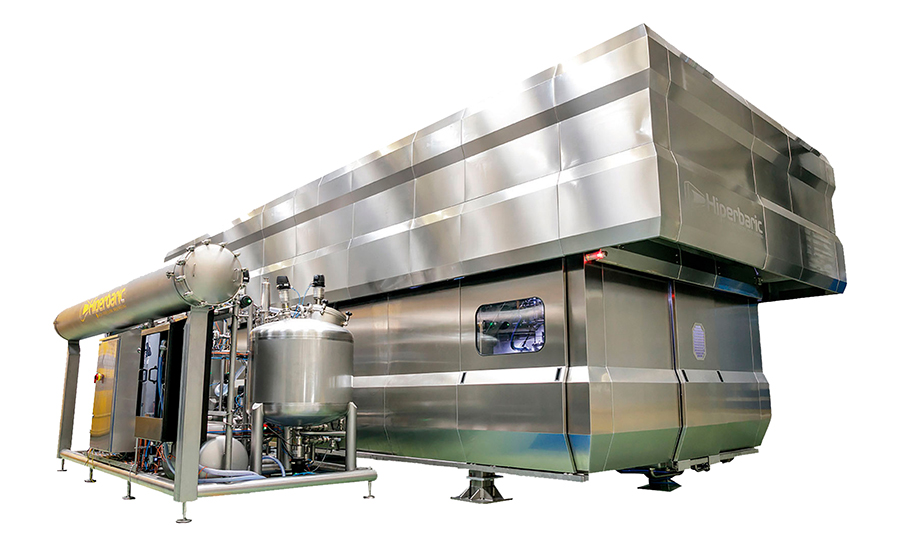
Automating Material Handling?
Whether or not you decide to integrate automated material handling to, from and for loading/unloading an HPP system will depend on product flow and weight plus throughput. Obviously, the more you can keep the HPP operating, the lower the cost to your final product if you own the HPP equipment.
“HPP systems are typically fed via a conveyor system that may have automation,” says CRB’s Jerry Steenhoek, senior director of automation technology. “The takeaway system is typically some type of conveyor or packaging line. There may be some automation on these systems. Most HPP systems have a basket system that needs to be loaded prior to processing and unloaded after the processing. If the product(s) you are running through the HPP process are consistent, you perhaps could utilize robots in this capacity. The HPP systems I have seen, the baskets tend to be cylindrical, which could be an issue for robots.”
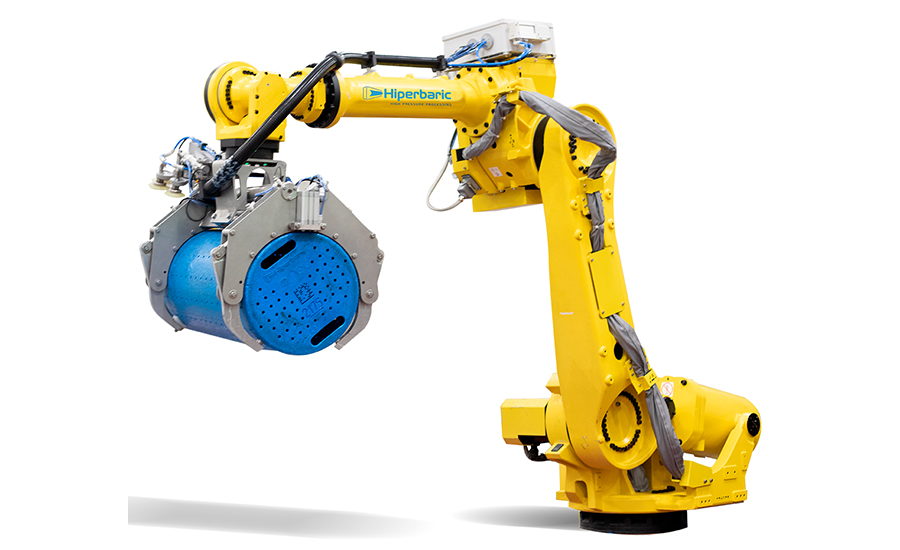
“We are investigating fully and semi-automatic loading and unloading systems,” says Quintus’s Williams. “Currently there are limited options particularly with the geometrical issues of dealing with a round cylinder basket.”
With the help of system integrators, Hiperbaric has been able to integrate robots with specially designed grippers to handle the cylindrical product baskets. The robots can aid in the loading/unloading of the baskets with product and placing them on the loading belt going into the HPP machine. Material handling is simplified with RFIDs and data matrix codes placed on the HPP baskets to track inventory, automate setup and provide trace capability. Pick-and-place-robots can also be used to sort products for packaging after exit from the HPP equipment.
Who Uses HPP?
In the earlier days, Quintus Technologies built a large number of HPP systems under Avure’s name, says Williams. “Customers who are using the technologies were pleased with their products. HPP systems performed to high standards in the food industry with high consumer satisfaction.”
“Several companies producing RTE meat, pet food, guacamole, seafood, baby food, beverages have successfully implemented HPP systems in North America, Europe, Latin America and APAC regions,” says JBTAvure’s Raghubeer. “In addition to the large global network of HPP service providers, many companies operate their own HPP systems such as Wholly Guacamole, Good Foods, Prestige Oysters, Hormel Foods, Hyungkuk F&B, Gordian, Motivatit Seafood, Frutas Montosa, Stella & Chewy’s, and several others.”
Hiperbaric’s Zapata added to the list Suja Juice, MUSH, Demakes Enterprises (Old Neighborhood Foods), The Alpine Wurst, Greenhead Lobster, Seafarers and Suzannah’s Kitchen. Tolling companies—aka contract manufacturers—include Youngstown Distributors, Dora’s Naturals, Universal Pure, Green Plant, Lineage, LiDestri Foods and Maryland Packaging. Evolution Fresh and Lineage use Hiperbaric HPP Automation Services.
Tolling Services
Tolling, or contract manufacturing, is well established for HPP, and there are multiple locations throughout the U.S., says CRB’s Moses. The Cold Pressure Council is another place to find contract manufacturers, including Universal Pure, West Liberty Foods and American Pasteurization Company. You can even find universities with capabilities, such as University of Nebraska.
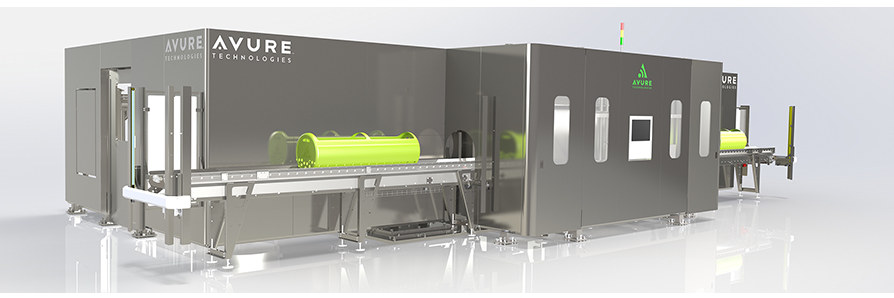
According to Zapata, there are more than 30 commercial tolling facilities in the U.S. alone. Most tolling centers are located strategically based on food industry hubs. For example, in the U.S., California, Texas, Illinois, New York and Florida have multiple tolling sites. Facilities near fresh produce regions (e.g., California) or meat processing centers (e.g., Nebraska) allow easier access for those industries. International tolling providers target processors exporting to or located near their region. There are also tollers in Salt Lake City (Intermountain HPP) and Miami (Green Plant).
According to Kevin Kennedy, JBTAvure North American sales manager, the company’s tolling network serves an important role for many HPP prospects/customers by facilitating their entry into the commercial market. Currently, there are more than 20 companies in 28 locations throughout North America, Canada, South America, South Africa, Europe and Asia.
Resources:
“Engineering R&D: MAP for HPP,” FE, 3 May 2012, Kevin Higgins
“Fully-automated HPP Production Line Featuring Hiperbaric 525 System,” YouTube video, https://www.youtube.com/watch?v=U21mrjc7Cy4
Cold Pressure Council, website: https://www.coldpressurecouncil.org/
Looking for a reprint of this article?
From high-res PDFs to custom plaques, order your copy today!







